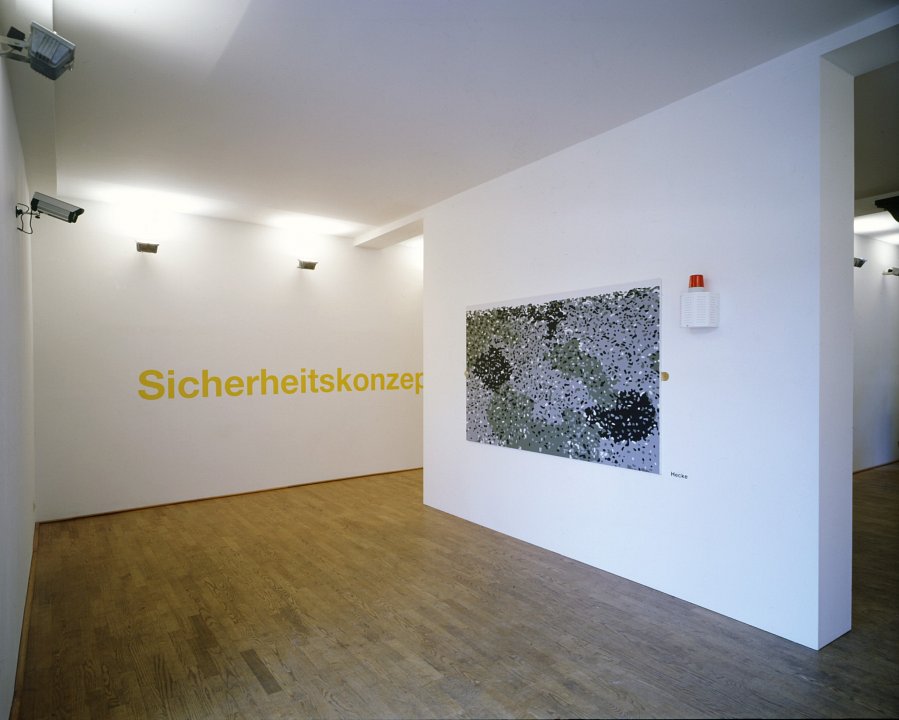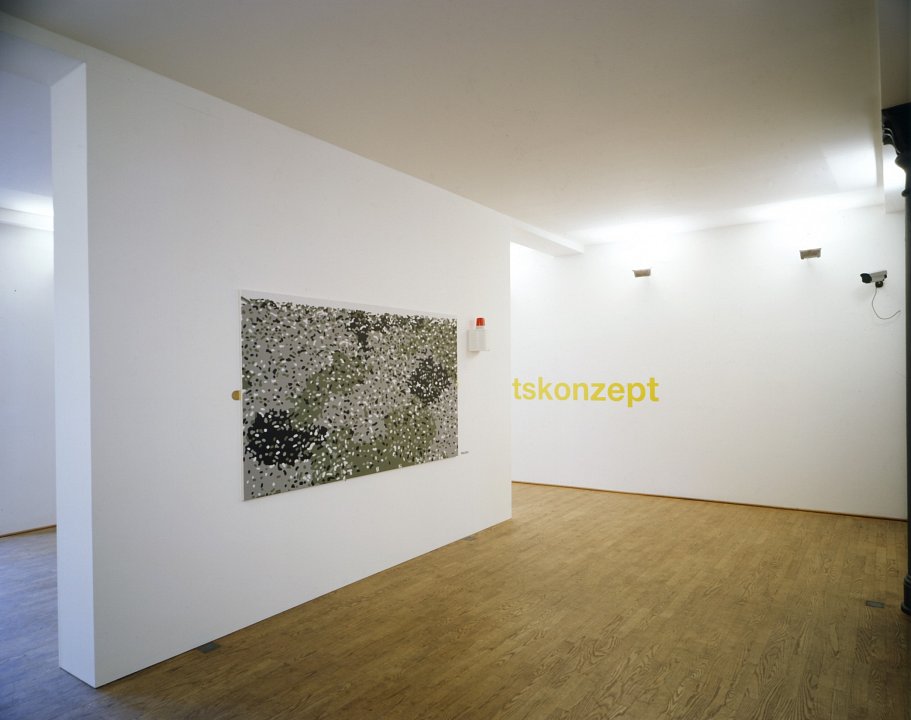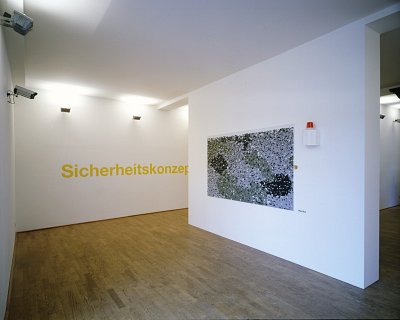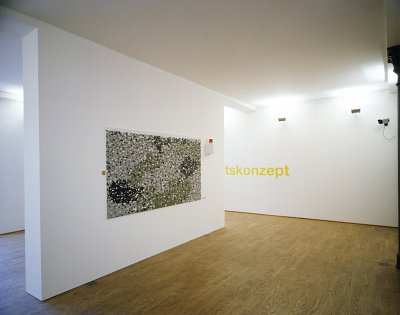Matten Vogel
Sicherheitskonzept
-

Sicherheitskonzept, installation view, Kuckei + Kuckei, 2000
-

Sicherheitskonzept, installation view, Kuckei + Kuckei, 2000
-

Sicherheitskonzept, installation view, Kuckei + Kuckei, 2000
-

Sicherheitskonzept, installation view, Kuckei + Kuckei, 2000
Almost everyone knows the feeling of fear in one form or another. Along with joy, grief, anger, guilt, and shame, fear is one of the basic emotions that accompany every person through life. Cognitive theories of fear view it as the result of loss of control due to unfamiliarity, uncertainty, loss of security, abandonment, anticipation of threat, an unclear future, loss of hope, etc. Fear has become one of the most important topics in the psychology of emotions, and all important psychotherapeutic facilities seek to eliminate morbid fear. People in the United States sometimes use the German word “Angst” to describe an attack of panic. Americans often view Germans as especially fearful and at the same time as obsessed with minor rules, even as being downright fetishistic about security. This, although general safety standards in Germany are no higher than in other European countries.
In a world sought home by constant disasters, even if the attempt were made to tie up social life together in ever more complicated safety nets, primal human fears could not be eliminated. Everything to do with ensuring against the pitfalls of life, fate, and one’s own inability is a perpetual theme. Fear-pleasure and the pleasure of the law sometimes overlap. Psycho-courses, sects, and private security services are booming.Because the police no longer have enough money and personnel to guarantee the security of citizens in Germany, private security services are mushrooming. The news magazine DER SPIEGEL reports that 250,000 people already work for such firms – as many as for the police. But what is to be done? Put up fences, install surveillance cameras, isolate perpetrators, exclude foreigners, or talk about the phenomena of crisis in the economy, environment, military power constellations, etc.? The growth of right-wing radicalism and its international Internet networking are cited as necessitating the use of all relevant state means against the fear of a “threat”. But doesn’t this syndrome, which seems capable of being triggered at any time, arise from deeper problems of credibility in the democratic way of life? For the political observer, politicians’ personal lack of credibility reflects what lacks credibility in democracy itself. How can democracy be protected against lack of credibility and the professionalized glibness of the politicians? Fear is a poor counselor, as the saying has it. So the solution can lie neither in unprofessional chumminess with the vox populi, nor in wrapping oneself in “concern” in candlelight demonstrations in the wrong place. Can art help us out of the old system-mix of fears, constraints, and promises for the future? Of course not. But, if they are supported by form, conceptual images and stories from the back of the mind are always good for giving impulses, whether they increase or reduce security in oneself.
With his works in the exhibition “Security Concept” (consisting of “Safety First, trendy version”, “Safety First, normal version”, and “Counter”), Matten Vogel connects confusions in the societal subconscious with the current discourse on painting. The experimental setup of “Security Concept” consists of a wall (400 cm wide, variably high), two pictures, two alarm sirens, and two video surveillance cameras. In accordance with the respective exhibition room, the artificial presentation wall is set up like a sculpture to create a spatial mirror relationship. On each side of the wall hangs a picture (each 130 × 220 cm; motif: a box tree hedge) with a conspicuous metal picture-securing device mounted sideways, flanked on the upper right corner by a standard red warning beacon.
A conspicuous caption bears the (revealing) title “Hedge”. The protective function of the hedge is taken up by the wall, which refuses any glance through it. Both “hedge” motifs derive from a photographic original taken in Berlin’s Neukölln district, Germany’s urban district with the highest number of social welfare recipients, where the artist found conspicuously view-blocking hedges. The photos were processed on a computer, rounding the forms and changing the colors. In terms of compositional structure, the two pictures are like mirrors of each other. In terms of the pictures’ color, Vogel based the normal version completely upon the camouflage colors introduced by Germany’s army, the Bundeswehr, using the tones: bronze green RAL 6031, leather brown RAL 8027, and tar black RAL 9021. (1) The trendy version is in the military colors of the 1999-2000 fashion season: gray/green/black.
Camouflage means adapting to the respective surroundings – a sly deceit copied from the animal kingdom that promises the greatest possible degree of security. Camouflage-colored clothing is currently at the top of young boys’ wish lists. Since “Tank Girl”, “Lara Croft”, and the new image of the seductive, superpatriotic armed woman, haute couture is no longer imaginable without camouflage fabric. That this “hedge” duo has the quality of classical panel paintings and is not simply a paint-washed surface is especially clear from the formal ponderation and the elaboration of the work’s painterliness. The “flickering” of the upper edge of the picture, created by the fraying of the conglomerate of spots against a white surface, lives from the collision of two principles, a neo-impressionistic and an organic one.
Compared with Vogel’s earlier coolly monochromatic, surface-oriented, acrylic lacquer surfaces, this kind of painting, which challenges the optical equipment of vision, is more interested in individual self-expression. At the same time, it uses the developments in the digital media and responds to pixel-supported image aesthetics. A new dimension in the work of this artist. Oriented directly toward the center of the pictures, Vogel also secures his camouflaged surfaces with surveillance cameras from the respectively opposite walls. Everything looks deceptively real. Whereby the visitor cannot immediately grasp what the actual artwork is: a picture, two pictures, or even both pictures together with the technical apparatus around them. The sirens and the cameras are mere dummies, underscoring the nonfunctional character of the installation as a security system and elevating the “Security Concept” into an artwork with a broad associative context.
Matten Vogel presents a reproduction of security madness at its extreme when he has camouflage pictures observed by cameras. Fear is the central object of examination here, as well. Fear that overlaps the visitors’ pride, for even purchasing expensive surveillance equipment cannot guarantee that it will function in the decisive moment.
Another work (“untitled”) shows the portrait of a man (it is the artist himself) as if taken by a camera recording a bank robbery. Next to it is placed a camera of exactly this type. The camera blinks and seems to be recording, but in reality registers nothing. Again we have a system seeming to promise security but unable to produce relevant information (except as a work of art), nor to stop itself. Irreducibly entangled connections of meaning between everyday reality, the reality of art, and the reality of the fake make it impossible to orient oneself. Even the practiced media specialist is stymied. But if the visitor believes he has finally seen through Vogel’s artistic strategies, he is already caught in the trap. Vogel is a dodgy underminer of possible one-dimensional interpretations by viewers. This is the only way constructions of meaning that deviate from normality can become relevant.
The installation “Counter” offers an example of this tactic. It consists of a classic reception counter, as found in every company’s lobby, equipped with monitor and surveillance camera. This time the equipment works, but the monitor shows a different room situation than the given one; however, the visitor notices this only after the most painstaking inspection of his surroundings. The camera placed under the counter is filming in real time, but it is not focused on observing the room. It registers only a single still photo of the room that Vogel has glued a few centimeters away from the lens. With this, Vogel votes for an emancipated use of the media by responsible recipients, who should be able to distinguish between the information broadcasted and the message conveyed and to make the effort of a critical interpretation, true to the claim by Marshall McLuhan (“The medium is the massage”) that the medium is an essential part of the communication situation. (Christoph Tannert)
(1) Cf. Johannes Denecke, Tarnanstriche des deutschen Heeres 1914 bis heute [Camouflage Paint of the German Army 1914 to Today], Bernard & Graefe Verlag, Bonn 1999, p. 89 ff. The abbreviation RAL stands for “Reichsauschuß für Lieferbedingungen und Gütesicherung” [“Imperial Committee for Conditions of Delivery and Quality Control”] and refers to the German association, founded in 1925, that in 1927 published the first color tone chart with 40 color tones for standard and official colors, most of which could be mixed using domestic pigments.